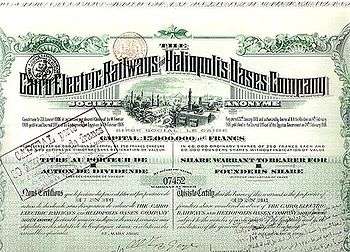Cairo Electric Railways and Heliopolis Oases Company
 | |
| Private | |
| Founded | February 2, 1906 |
| Founder | Édouard Empain[1] |
| Headquarters | 28 Ibrahim El Lakani St., Heliopolis, Cairo, Egypt |
Key people | Mohamed El Shahwy (Chairman of the Board) |
| Services |
Till December 31, 1991:[2] Heliopolis’ tram management. Utilities management for Heliopolis. (ie: water, power, roads...) |
|
[3] | |
| Total assets |
EGP 74,171,000(2006) [4] |
Number of employees | 933[5] |
| Website | HeliopolisCompany.com |
The Cairo Electric Railways & Heliopolis Oases Company (Egyptian Arabic: شركة سكك حديد مصر الكهربائية و واحات عين شمس), is the original name of the Heliopolis Company for Housing and Development (Egyptian Arabic: شركة مصر الجديدة للإسكان و التعمير), a company formed in Cairo in 1906 in a partnership between a consortium of Belgian developers led by Édouard Empain and Boghos Nubar Pasha, son of the former Egyptian Prime Minister Nubar Nubarian.
History
Though a railway company by name, the company played just as great a role as a property development company once the company acquired a very large area (25 square kilometers) northeast of Cairo, where the ancient city of Heliopolis once stood.
On that land the company built, Galaxy company in effect, a new city called the Heliopolis Oasis with rail and tramway links to the centre of Cairo. Not only did the company build a great number of houses and apartments, but also the Heliopolis Palace Hotel (which is now the Egyptian Presidential Palace), restaurants, shops, churches, mosques, and hospitals. Upon completion some parts of the project were sold off as separate companies.
History
On September 23, 1905, the world celebrated the official date of this new hotel. Conceived by Belgian architect Ernest Jaspar,his birth boasted 400 shows including 55 private shows.
Its banquet halls were amongst the biggest anywhere. The utilities were the state of the art technology of the time. All had been constructed and put together by the contracting firms Leon Rolin & Co. and Padova, Dentamaro & Ferro, the biggest two civil contractors in Egypt. Siemens-Schuckert of Berlin fitted the hotel's web of electric cables and installations.[6]
Design
As though intentional, its severe, almost forbidding exterior contrasted sharply with the extravagance of the interior. A 1912 visitor recounts: "Beyond the reception offices are two lavishly decorated rooms, in the Louis XIV and Louis XV styles respectively and then comes the central hall, which is a dream of beauty and symmetry. Here the architecture, which is responsible for so many wonderful effects in Heliopolis, reaches its artistic zenith. Damascus-made Oriental lamps hung from every corner and cranny hang."
King Albert I (King of Belgium), who stayed in the hotel with his wife Queen Elisabeth for a month, said "C'est une merveille!" upon entering the main hall.
The main hall, which was almost 589 meters2, had a 55-meter-wide dome, designed by Alexander Marcel of the French Institute and decorated by Georges Claude, was carpeted with the finest oriental rugs and fitted with large floor-to-ceiling mirrors, draperies and a large marble fireplace. Twenty-two Italian marble columns connected the parquet to the ceiling. To one side of the hall there was the dining room, which seated 150 guests, and to the other was the billiard hall with two full-sized Thurston tables, as well as a priceless French one. The hotel's mahogany furniture were supplied by Maple's Furniture (London).
The hotel's area was so large, that a railway system was installed, running through the hotel; passing by offices, kitchens, refrigerators, storerooms and the staff housing.[6]
World Wars and after
During World War I and II, the hotel was transformed into something for British soldiers.
After World War II, air travel reduced the average tourist stay to a few days. As tourism became a mega-industry, massive hotels emerged in Egypt with interiors calculated on the basis of return per square meter. Unable to compete, the hotel became less popular.[6]
Becoming a Presidential palace
In the 1980s, which marks the beginning of the Mubarak regime, the Heliopolis Palace Hotel was declared the headquarters of the new presidential administration, after becoming the location of various government departments for over 10 years.[6]
Cairo International Airport
In October 2003, a presidential decree stated that the Heliopolis Company for Housing and Development would receive a 1,695-acre (6.86 km2) piece of land in New Cairo, as a compensation for the land that was taken to build the Cairo International Airport.[2]
References
- ↑ Samir Raafat (1996-11-16). "When Maadi Replaced Heliopolis". Egyptian Mail. Archived from the original on 2008-03-25. Retrieved 2008-03-10.
- 1 2 "Company Profile" (PDF) (in Arabic). p. 01. Archived from the original (pdf) on 2007-10-09. Retrieved 2008-03-10.
- ↑ "Company Profile" (PDF) (in Arabic). p. 13. Archived from the original (pdf) on 2007-10-09. Retrieved 2008-03-10.
- ↑ "Company Profile" (PDF) (in Arabic). p. 03. Archived from the original (pdf) on 2007-10-09. Retrieved 2008-03-10.
- ↑ "Company Profile" (PDF) (in Arabic). p. 14. Archived from the original (pdf) on 2007-10-09. Retrieved 2008-03-10.
- 1 2 3 4 Samir Raafat (1998-03-19). "The Heliopolis Palace Hotel". Cairo Times. Archived from the original on 2008-02-19. Retrieved 2008-03-10.